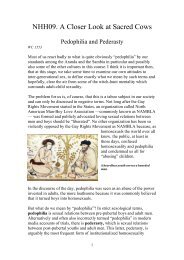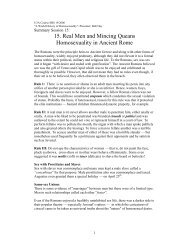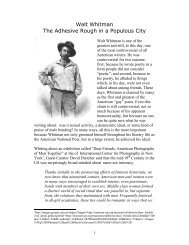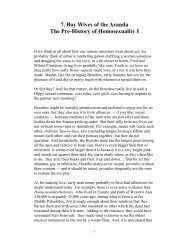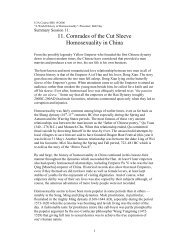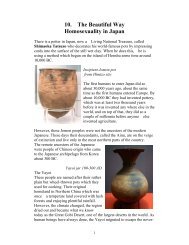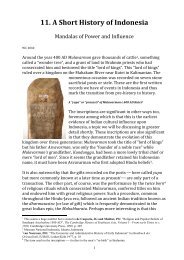NHH 10 The Beautiful Way - Homosexuality in Japan
NHH 10 The Beautiful Way - Homosexuality in Japan
NHH 10 The Beautiful Way - Homosexuality in Japan
You also want an ePaper? Increase the reach of your titles
YUMPU automatically turns print PDFs into web optimized ePapers that Google loves.
come out <strong>in</strong> actual life. Yet, as recent research has shown 15 , the<br />
notion of 'com<strong>in</strong>g out' is seen as undesirable by many <strong>Japan</strong>ese gay<br />
men and lesbians as it necessarily <strong>in</strong>volves adopt<strong>in</strong>g a<br />
confrontational stance aga<strong>in</strong>st ma<strong>in</strong>stream lifestyles and values,<br />
which many still wish to endorse.<br />
It is difficult to assess exactly what is meant by “homosexuality” <strong>in</strong> <strong>Japan</strong><br />
because the media seem to conflate same-sex desire with cross-dress<strong>in</strong>g<br />
and trans-genderism and at times to portray it as a k<strong>in</strong>d of “hobby” or a<br />
form of “play”. This rather confused and trivializ<strong>in</strong>g attitude can be best<br />
seen <strong>in</strong> two major <strong>in</strong>stitutions of <strong>Japan</strong>ese contemporary life: <strong>in</strong> the comic<br />
books called manga and their animated form, called anime.<br />
Anime and Manga<br />
Many manga and anime conta<strong>in</strong> male homosexual stories and bedroom<br />
scenes. S<strong>in</strong>ce the 1970s, a genre of manga and anime has developed<br />
especially for women fasc<strong>in</strong>ated by the “boy-love” theme, a genre<br />
<strong>in</strong>creas<strong>in</strong>gly written and drawn by women themselves. <strong>The</strong>se feature very<br />
stylized, fem<strong>in</strong>ised youths, known as bishoonen which many<br />
commentators argue are not really men but:<br />
…fantastic, androgynous creatures created by <strong>Japan</strong>ese women as<br />
an expression of dissatisfaction with current gender stereotypes<br />
and the 'narrow life paths' which restrict women <strong>in</strong> the real<br />
world. 16<br />
However, there is evidence that these notions are more than just daydreams<br />
for many women who, s<strong>in</strong>ce the early '90s, have come to believe<br />
it is better to live with and even to marry a gay man. As McLelland<br />
reports, these women believe gay men have qualities straight men lack,<br />
<strong>in</strong>clud<strong>in</strong>g a will<strong>in</strong>gness to negotiate roles with<strong>in</strong> the marriage and to help<br />
with housework.<br />
Relationships between straight women and gay men are also the focus of<br />
what are called "gay boom" movies <strong>in</strong> which a common theme is<br />
'camouflage marriage'. <strong>The</strong>se marriages are undertaken to avoid the<br />
<strong>in</strong>tense social pressures on both partners to marry and are welcomed by<br />
women because they believe gay men offer them ……the k<strong>in</strong>d of love,<br />
appreciation and respect denied to them by straight men.<br />
15 McLelland refers to his own Male <strong>Homosexuality</strong> <strong>in</strong> Modern <strong>Japan</strong>: Cultural Myths and Social<br />
Realities, Richmond: Curzon Press – then <strong>in</strong> press; and to Wim Luns<strong>in</strong>g, Beyond Common Sense,<br />
1999a.<br />
16 McLelland, ibid.<br />
<strong>10</strong>



